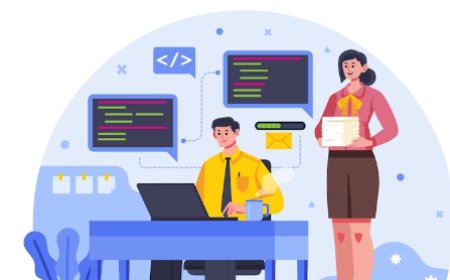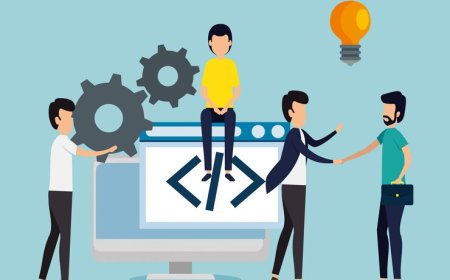Introduction to Python Programming Best Practices
Learn the best practices for Python programming with our introduction. Discover essential tips for writing efficient, readable, and maintainable Python code

Python as a Popular Programming Language:
Python is a widely recognized and highly popular programming language. Known for its simplicity, readability, and versatility, Python is often the first choice for both novice and experienced programmers. Its extensive standard library and a thriving community of developers contribute to its widespread adoption. Python is utilized across various domains, including web development, data analysis, machine learning, and more. Its straightforward syntax allows developers to express concepts with fewer lines of code, making it a go-to language for many.
Following Best Practices When Coding in Python:
While Python's user-friendly nature is one of its strengths, it can also lead to code that lacks structure and clarity. This is where adhering to best practices becomes crucial. Python has a set of guidelines and conventions known as PEP 8 (Python Enhancement Proposals) that outline coding standards. Following these best practices ensures code consistency, readability, and maintainability. Clean and well-structured code not only benefits the original developer but also anyone who works on the project later. It reduces the chances of introducing errors, speeds up debugging, and streamlines collaboration among team members.
Efficient and Clean Code in Python Projects:
Efficiency and cleanliness in Python code are paramount for several reasons. First, efficient code results in better performance, which is essential for applications like web services and data analysis. Second, clean code is easier to understand, reducing the learning curve for new developers who join a project. It also minimizes the chances of introducing bugs during maintenance or feature additions. Moreover, Python's extensive use in data science and machine learning demands well-organized code for experimentation and model deployment. In summary, efficient and clean code is not just a best practice; it's a fundamental requirement for successful Python projects.
The challenges faced in the Python ecosystem:
The complexity of the Python Ecosystem: With the extensive array of libraries and frameworks, maintaining code quality can be challenging due to the complexities involved in navigating the diverse Python ecosystem.
Consequences of Inadequate Best Practices: Without standardized guidelines, coding practices might lack uniformity, resulting in code that is difficult to maintain and debug, leading to potential inefficiencies within Python projects.
Differing Perspectives on Best Practices: Varying opinions among developers concerning what constitutes best practices can create discrepancies in coding styles, potentially leading to conflicts and inconsistencies within collaborative Python projects. To mitigate these challenges, promoting awareness about established best practices, such as PEP 8 coding standards, can aid in fostering uniformity and enhancing the overall quality of Python codebases.
Here are some key best practices for Python programming
Adhere to PEP 8 Guidelines:
PEP 8 is the official style guide for Python, and following it ensures that the code is consistent and readable. This consistency is essential for collaborative projects, making it easier for team members to understand and modify code.
Use Virtual Environments:
Virtual environments provide isolated spaces for Python projects, allowing developers to manage project-specific dependencies effectively. This prevents conflicts and ensures that each project has its own clean environment.
Write Unit Tests:
Unit testing is a fundamental practice for identifying and addressing bugs early in the development process. It involves writing test cases to validate individual code components. Robust unit tests provide confidence in the reliability of the code.
Document Code Properly:
Comprehensive code documentation is essential for code comprehension. It not only helps the original developer understand their own code but also facilitates collaboration among team members. Clear documentation also simplifies maintenance.
Perform Code Reviews:
Regular code reviews are a crucial part of the development process. They promote knowledge sharing, ensure that the codebase adheres to best practices, and identify potential issues early. Code reviews improve code quality and foster a culture of collaboration.
Tools and techniques that can assist:
Linting Tools: Tools like Flake8 and Pylint help identify code inconsistencies and enforce coding standards.
Code Formatters: Utilizing tools such as Black and autopep8 aids in automatically formatting code according to PEP 8 guidelines.
Integrated Development Environments (IDEs): IDEs like PyCharm and Visual Studio Code offer features that support code analysis, debugging, and refactoring, promoting efficient development practices.
Code Readability and Adherence to PEP 8:
-
Code readability is crucial for maintainable and collaborative projects. It ensures that code can be easily understood and modified by others.
-
Adherence to PEP 8, Python's style guide, enforces consistent code formatting, making it easier for developers to read and follow best practices. It covers naming conventions, indentation, and more.
Virtual Environments for Dependency Management:
-
Virtual environments create isolated spaces for Python projects, preventing conflicts between different project dependencies.
-
Popular tools like ‘virtualenv’and ‘venv’ allow developers to manage dependencies efficiently.
Data Structures, Error Handling, and Documentation:
-
Proper data structure selection can significantly impact program efficiency and readability. Python offers a variety of built-in data structures like lists, dictionaries, and sets.
-
Effective error handling ensures that programs gracefully recover from unexpected issues, enhancing the user experience.
-
Documentation, both in code comments and external documentation, provides clarity to code functionality and usage.
Benefits of Version Control Systems like Git:
-
Git enables version tracking, which is essential for collaboration. It allows multiple developers to work on the same project, merging changes seamlessly.
-
It provides a history of code changes, facilitating debugging and accountability.
Insights into Unit Testing and Continuous Integration:
-
Unit testing involves writing test cases for individual code components. It helps catch bugs early, ensuring code reliability.
-
Continuous Integration (CI) automates the testing and integration of code changes, reducing the risk of integration issues. Tools like Jenkins and Travis CI are commonly used.
Role of Code Reviews and Collaboration:
-
Code reviews involve peer evaluation of code to identify issues, maintain quality, and share knowledge among team members.
-
Collaboration promotes knowledge sharing and ensures that team members are aligned in their development approach.
Tips for Optimizing Python Code for Performance:
-
Use appropriate data structures and algorithms for specific tasks.
-
Minimize I/O operations and avoid unnecessary computations.
-
Utilize libraries like NumPy for numerical operations.
Resources and References for Further Learning:
-
Online platforms like Python.org, Real Python, and Codecademy offer tutorials and documentation for Python.
-
Books like "Fluent Python" by Luciano Ramalho and "Effective Python" by Brett Slatkin provide in-depth knowledge.
It's important to keep in mind that following Python programming best practices is key to crafting code that is efficient, reliable, and easy to maintain. By adhering to established guidelines like PEP 8, using virtual environments, and implementing proper documentation and testing, developers can ensure that their code is readable, consistent, and collaborative. Additionally, emphasizing code reviews and continuous integration can help to further enhance code quality and promote a culture of teamwork and excellence in software development.





































